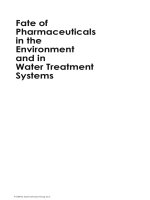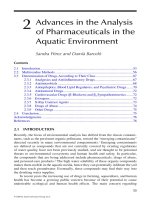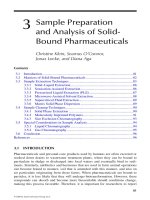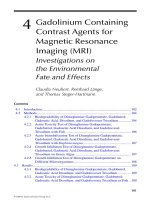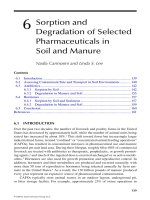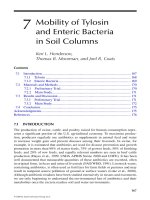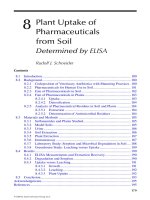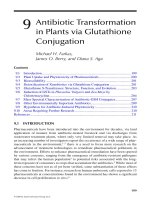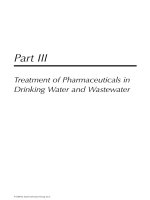Fate of Pharmaceuticals in the Environment and in Water Treatment Systems - Chapter 7 pot
Bạn đang xem bản rút gọn của tài liệu. Xem và tải ngay bản đầy đủ của tài liệu tại đây (191.1 KB, 12 trang )
167
7
Mobil ity of Tylosin
and Enteric Bacteria
in Soil Columns
Keri L. Henderson,
Thomas B. Moorman, and Joel R. Coats
7.1 INTRODUCTION
Theproductionofswine,cattle,andpoultryraisedforhumanconsumptionrepre-
sents a signicant portion of the U.S. agricultural economy. To maximize produc-
tion, producers regularly use antibiotics as supplements in animal feed and water
to increase weight gain and prevent diseases among their livestock. In swine, for
example, it is estimated that antibiotics are used for disease prevention and growth
promotioninmorethan90%ofstarterfeeds,75%ofgrowerfeeds,50%ofnishing
feeds,and20%ofsowfeeds,andequallyrelevantnumbersareseeninbeefcattle
production(Hayesetal.,1999;USDAAPHISSwine2000andCOFE).Ithasbeen
well documented that measurable quantities of these antibiotics are excreted, often
inoriginalform,infecesandurineoflivestock(FAO/WHO,1991).Livestockwaste,
containingantibiotics,isoftenusedasfertilizerforfarmeldsorpasturesandmay
resultinnonpointsourcepollutionofgroundorsurfacewaters(Lokeetal.,2000).
Although antibiotic residues have been studied extensively in tissues and excrement,
we are only beginning to understand the environmental fate of antibiotics and their
metabolites once the excreta reaches soil and water environments.
Contents
7.1 Introduction 167
7.1.1 Tylosin 168
7.1.2 Enteric Bacteria 169
7.2 Mater ials and Metho ds 170
7.2.1 Preliminary Trial 170
7.2.2 Main Study 171
7.3 Results a nd Discussion 171
7.3.1 P reli mi na r y Tria l 171
7.3.2 Main Study 172
7.4 Conclusion 175
Ack nowledgments 175
References 176
© 2008 by Taylor & Francis Group, LLC
168 Fate of Pharmaceuticals in the Environment and in Water Treatment Systems
Recently, antibiotics, including the veterinary antibiotic tylosin, which is
describedinthisstudy,werefoundin48%of139streamwaterstestedin30states,
accordingtotheU.S.GeologicalSurvey(Kolpinetal.,2002).Antibioticsenter-
ing the environment could potentially alter bacterial populations and their activity
in sediment and water, thus affecting biodegradation, nutrient cycling, and water
quality. In addition, there is concern that antibiotics in the environment may induce
antibiotic resistance, resulting in adverse human health effects. Certainly, there is
signicant evidence for development of antibiotic resistance within animals and in
the excretion of antibiotic-resistant bacteria in manure (Beaucage et al., 1979; Aar-
estrupetal.,1997;Kelleyetal.,1998).Muchlessisknownabouttheabilityoflow
concentrations of antibiotics to induce resistance in the environmental microbial
population or to provide selective pressure for maintenance of antibiotic resistance
genes among microorganisms, although the transfer of antibiotic resistance from
agriculturalsettingstohumanshasbeenreported(Oppegaardetal.,2001).
7.1.1 TYLOSIN
Tylosinisamacrolideantibioticwithactivityagainstgram-positiveandcertain
gram-negative bacteria, including Staphylococcus, Listeria, Legionella, and Entero-
coccus.Ithaslittleactivityagainstgram-negativeentericbacteriasuchasE. coli.
Tylosin is used exclusively in veterinary applications and is closely related to eryth-
romycin,whichhasanimportantroleinpublichealth.Tylosinconsistsoffourmajor
factors:tylosinA,B,C,andD(Figure 7.1);eachofthefactorsisbiologicallyactive,
withtylosinAbeingmostactiveandmostprevalentinmedicinalandfeedformula-
tions (Teeter and Meyerhoff, 2003). Tylosin acts in bacteria by binding to the 50S
ribosome subunit, which leads to inhibition of protein synthesis. Sensitive bacteria
areinhibitedbyaslittleas500µg/L.Tylosinisusedasagrowthpromoterapplied
inswinefeedandasatherapeuticproductinswineandcattle.Tylosinisacom-
mon antibiotic used internationally in swine, cattle, and poultry production as both
a therapeutic and a prophylactic (Massé et al., 2000; Rabølle and Spliid, 2000). In
swineproduction,tylosinisamongthethreeantibioticsthataccountedforthemajor-
ity(78.8%)ofdiseaseprevention.Tylosinwasthemostusedantibioticat31.3%of
O
O
O
OH
N(CH
3
)
2
O
CH
3
O
HO
CH
3
OH
CH
3
O
H
3
C
HO
OR
2
OCH
3
O
O
R
1
CH
3
O
H
3
C
CH
3
H
3
C
OH
FIGURE 7.1 Chemical structure of tylosin including factors: A (R
1
=CHO, R
2
=CH
3
); B
(TYLAminusmycinose);C(R
1
=CHO, R
2
=H); and D (R
1
=CH
2
OH, R
2
=CH
3
).
© 2008 by Taylor & Francis Group, LLC
Mobility of Tylosin and Enteric Bacteria in Soil Columns 169
swineproductionfacilitiessurveyed(BushandBiehl,2001).Ithasbeenshownthat
tylosinistransformedintheanimalfromtylosinAtotylosinD,whichisachange
fromanaldehydetoanalcoholonthemacrolidering.However,tylosinDmaybe
convertedbacktoitsoriginalforminexcreta(FAO/WHO,1991).Concentrationsof
tylosininswinefeedrangefrom10to100gtylosin/tonfeedforgrowthpromotion
purposes (Elanco Animal Health Tylan
®
Premix product label).
Tylosinwaslistedinthetoptenmostfrequentlydetectedantibioticsinsurface
waterfrom1999to2000(Kolpinetal.,2002).Boxalletal.(2003)identiedtylo
-
si
nasakeypharmaceuticalofinterestintheenvironment.Severalstudieshave
shownthatthisantibioticmayhaveanafnityforclayparticlesandorganicmatter
insoil,aswellastheorganiccomponentsofmanure,whichcouldaffectitsability
todegrade(RabølleandSpliid,2000;Kolzetal.,2005).Sorptiontosoilandmanure
components may affect its bioavailability. Huang et al. (2001) described tylosin as
oneofthemostlikelywatercontaminantsfromagriculturalrunoff.Duetoitssorp
-
tion characteristics, it is believed that tylosin would be transported with sediment
duringarunoffevent(Davisetal.,2006).Veryfewstudieshaveevaluatedmobility
anddegradationintheenvironmentinthepresenceofamanuresubstrate(Rabølle
and Spliid, 2000; Kay et al., 2004; 2005); however, these studies assessed only total
tylosinresiduesanddidnotquantifytylosinmetabolites.Sorptionofchemicalsonto
solidphases,suchassoil,sediment,ormanure,isextremelyimportantbecauseit
could affect the fate and impact of these substances in that environment. An under
-
st
andingofthedegradationandfateofveterinaryantibioticsinsoilisimportant
because of widespread use of the compounds in livestock production in the United
States, and the concurrent application of manure to land. Agricultural lands typically
contain subsurface tile drain networks, which may drain directly into streams and
other surface water bodies. Based on the lack of data regarding the leaching ability
of tylosin factors in soil, one objective of the present study was to address these data
gapsbyquantifyingtylosinresidues(specicallytylosinAandtylosinD)inleachate
fromtylosinappliedtosoilcolumnsinamanureslurry.
7.1. 2 E NTERIC BACTERIA
Two genera of enteric bacteria were selected for use in the present study. Escherichia
coli are g
ram-negative, rod-shaped members of H-Proteobacteria. Enterococcus sp.
are gram-positive cocci. Both E. coli and e
nterococcus inhabit the gastrointestinal
tractofmanymammals,includinglivestock,andareexcretedfromtheanimalsand
found in manure (Schleifer and Kilpper-Balz, 1987; Schaechter, 2000). Both organ
-
is
msarepotentiallypathogenicandcandevelopresistancetoantibioticsandhavethe
potentialtotransferresistancegenestootherbacteria(Wegeneretal.,1999;Ochman
etal.,2000).Thesebacteriaarealsousedasfecalindicatorspeciesforwaterqual
-
ity assessments (Molina, 2005). Because of these characteristics, it is important to
understand the survival and mobility of these microorganisms in the environment.
Severalresearchershavereported
E. coli surviving up to 8 weeks, and enterococcus
survivalrangingfrom35to>200dinsoils,dependingonsoiltexture,amountand
type of manure applied, temperature, and competition with indigenous soil micro
-
or
ganisms(Coolsetal.,2001;LauandIngham,2001;Andrewsetal.,2004;Entry
et al., 2005; Johannessen et al., 2005). A study examining the mobility of enteric
© 2008 by Taylor & Francis Group, LLC
170 Fate of Pharmaceuticals in the Environment and in Water Treatment Systems
bacteria in soil indicated 2 to 6% of the inoculated enterococcus leached through soil
columns; however, the bacteria were applied directly to the top of the soil rather than
in a manure slurry (Celico et al., 2004). Soupir et al. (2006) reported enterococcus as
beinghighlymobileinrunofffromasimulatedheavyrainfallevent;differenttypes
ofmanureweretestedandcountsrangedfrom6000to187,000cfu/100mL.
Asverylittleinformationisavailableonthefateofbacteriaexcretedinmanure
once the manure is applied to soil, particularly in the presence of drug residues,
another objective of the present study was to determine the survival, movement, and
antibiotic resistance of enteric bacteria in undisturbed soil columns.
7.2 MATERIALS AND METHODS
7. 2.1 PRELIMINARY TRIAL
TwentyintactsoilcoresofTamaseriessoilwerecollectedfromanagriculturaleld
nearGrinnell,Iowa.Theeldhadnotreceivedmanureapplicationforover20years,
thereby reducing the likelihood of background contamination of antibiotics in the
present study. The soil was a loam, containing 46% sand, 36% silt, and 18% clay.
Soilcores(10-cmdiameter×30-cmdepth)werecollectedusingaGiddingssoilcore
apparatus(GiddingsMachineCo.,Windsor,Colorado).Soilcolumnswereimmedi
-
ately taken to the lab and were saturated from the bottom with 5mM CaSO
4
for 48 h.
Soilcolumnswereplacedinshelvingunitsandrestedonfunnelspluggedwithglass
wool and lled with washed sea sand (Fisher Scientic, Pittsburgh, Pennsylvania),
so that the bottom of the soil column rested rmly on the sand. Soil columns were
allowedtodrain,andthosewithdrainagetimesof24to48hwerechosenforthe
experimentandwererandomlydividedamongtreatmentandcontrolgroups.
Freshhogmanurewascollectedfromhogsonanantibiotic-freediet(IowaState
University Swine Nutrition Farm, Ames, Iowa). Twelve-gram aliquots of manure
werepreparedand10mLultrapurewaterwasaddedtoeachaliquottomakeaeld-
representative manure slurry. The manure slurry was spiked with 60 μg tylosin
tartrateinamethanolcarriertoreachatylosinconcentrationof5ppminmanure.
Next,2×10
8
gfp-labeled ampicillin-resistant E. coli 0157:H7 B6914 were added to
the slurry. These organisms were selected for the preliminary trial because of their
ease of detection, relevance, and availability. The slurry was then poured onto the
surfaceofthecolumns.Theveuntreated(control)columnsreceived20mLultra
-
p
u
rewater,equivalenttothemoistureadditionofthetreatedcolumns.Afterapplica-
tionthetop2cmofthecolumnswererakedwithasterilizedspatulatosimulatethe
incorporationofmanureintosoilthatwouldoccurduringmanureapplicationinthe
eld.ThesemethodsaresimilartothosedescribedbySainietal.(2003).
Sandwaswettedwithultrapurewaterpriortoleachingevents.Forty-eighthours
afterapplication,a5-cm“rainfall”intheformof410mL5mMCaSO
4
was applied to
thecolumndrop-wiseover2.5to3.5h.Leachatewascollectedfromthebottomofthe
columns for 48 h, then immediately analyzed for tylosin and E. coli O157:H7 B
6914.
Theconcentrationoftylosininleachatewasdeterminedusingenzyme-linked
immunosorbent assay kits (ImmunoDiagnostic Reagents, San Diego, California) in
which the concentration was correlated to absorbance at 405 nm using a THER
-
© 2008 by Taylor & Francis Group, LLC
Mobility of Tylosin and Enteric Bacteria in Soil Columns 171
MOmaxmicroplatereaderwithSOFTmaxProV3.0software(MolecularDevices,
Sunnyvale, California).
The presence of gfp-labeled E
. coli O157:H7 in leachate was measured using a
most-probable number (MPN) technique (IDEXX, Westbrook, Maine). Total coli-
fo
rm bacteria were also enumerated using MPN.
The remaining leachate was concentrated using solid-phase extraction cartridges
(Waters Oasis
®
HLB,Milford,Massachusetts).Cartridgeswereconditionedwith5
mLacetonitrilefollowedby5mLof10%acetonitrile.Followingsampleretention,
cartridges were rinsed three times with 10 mL distilled water and 5 mL 10% aceto-
ni
trile. Tylosin was eluted from the cartridges with 2 mL of 98:2 acetonitrile:glacial
aceticacid.Extractswereanalyzedfortotaltylosin,tylosinA,andtylosinDusing
high performance liquid chromatography with tandem mass spectrometry (LC/MS/
MS
)withagra dientofa
mmoniumacetatepH4.0:acetonitrileover35minat40°C
onaZorbaxSD-C184.6×250mmcolumn(AgilentTechnologies,SantaClara,
California). Mass spectrometry was used for analysis of tylosin factors based on
mass, as reference standards for each factor were not available. Mass spectrometry
methods were similar to those described by Kolz et al. (2005). The limit of detection
was 0.5 μg/L.
7. 2 . 2 M AIN STUDY
Fifty-six soil columns were collected at the same site previously described. These
columnsweredividedamongseventreatmentgroups:control,manureonly,manure
plus Enterococcus,m
anure plus tylosin, tylosin plus Enterococcus,andmanureplus
tylosin only, and Enterococcus . Ente rococcus waschosenforthemainstudybecause
of its greater susceptibility to tylosin compared to E. coli,a
soneoftheobjectivesof
the present study was to evaluate development of resistance by manure-associated
bacteriainthesoilcolumns.Similarmethodswereemployedasthosepreviously
described, except the saturation and preleaching components were not performed,
and all soil columns were utilized, resulting in eight replicates per treatment group.
Additionally, we increased the concentration of tylosin and the amount of manure
applied to better represent real-world applications. Thirty grams of fresh hog manure
wasspikedwithtylosininanacetonecarriertoreachaconcentrationof50μg/g
tylosininthemanure.
Both enterococcus (which was inoculated) and
E. coli (from m
anure) were mea-
suredinleachatewateraftereachrainevent,andresultsareexpressedascellsper
100mLofleachatewater.Afewsampleswerenotsufcientlydilutedandthus
saturated the MPN panel, resulting in an MPN value that underestimates the true
concentration. These values were used in the data analysis. Control columns (no
manure)andcolumnstreatedwithmanureand
Enterococcus l
eached no E. coli.
7.3 RESULTS AND DISCUSSION
7. 3 .1 P
RELIMINARY TRIAL
Following a single rain event, analysis of leachate using LC/MS/MS revealed total
tylosinresiduesupto2.8ng/mL,withameanconcentrationof0.8ng/mL(se=
© 2008 by Taylor & Francis Group, LLC
172 Fate of Pharmaceuticals in the Environment and in Water Treatment Systems
0.3).Wefoundsimilarresultswhenusingimmunoassay;0.6ng/mLwasdetected
inleachate.WhenexaminingspecictylosinfactorsusingLC/MS/MS,wefound
thattylosinAaccountedforapproximately22%ofthetotaltylosinresidues;this
correspondstoaconcentrationof0.2ng/mL.TylosinD,anothermajorfactor,was
detectedat0.5ng/mL,or65%ofthetotalresidues.Thisresultisquiteinteresting
consideringthecompositionofthetylosinappliedtothetopofthecolumn;tylosinD
only accounted for approximately 10% in the formulation applied. Finding such dif-
fe
rent proportions in the leachate implies a differential metabolism or a differential
mobilitybetweentylosinAandD.ItispossiblethattylosinDismorestableormore
mobilethantylosinA.Furtherstudiesareneededtoelucidatethisphenomenon.
Additionally,tylosinDhasonly35%oftheantibacterialactivityastylosinA,
so the differences could have implications for low-level effects on soil microbial
communities(TeeterandMeyerhoff,2003).Eachoftheothertylosinfactors(Band
C), and even metabolites, can possess antimicrobial activity, which contributes to
acomplexsituationinsoilandwaterwithrespecttobiologicalactivity.Likewise,
some analytical methods, e.g.,ELISAr
esiduequantication,alsoaredifferentially
lesssensitivetosomefactorsormetabolitesandmoresensitivetoothers.Themajor
advantagetothehighperformanceliquidchromatography(HPLC) orLC/MS
method is the specicity, but the ELISA method is faster, cheaper, and can detect
verylowconcentrationsinaqueoussamples(Huetal.,2006).
FollowingMPNtestingofleachate,totalcoliformbacteriawerehighlyvari-
ableinmanure-treatedcolumns,witharangeof1to644CFU/mLinthreeofve
treatments.Onecontrolcolumnhad1cell/mLintheleachate,indicatingexternal
sourcesofbacteria,whichcouldincludewildlifefromtheareainwhichthecolumns
were collected. E. coli O157:H7 B6914 were detected in the leachate of two of the
vetreatedcolumns;theyalsorangedfrom1to644cells/mL(thelimitofdetection
for the assay).
Although<0.1%ofthegfp-labeledcellsandtylosinresiduesappliedtothetopof
thecolumnweredetectedintheleachateinthisstudy,theseresultsdoindicatethe
abilityoftylosinandsomebacteriatomoveinanagronomicsoil.
7.3.2 MAIN STUDY
Afterfourrainevents,lessthanone-thirdofthetreatedcolumnsleacheddetectable
amountsoftylosin,withtheaverageconcentrationat<1ng/mLinleachate.These
results were similar to those found in the preliminary trial.
There were no apparent differences in the E. coli leaching from any of the manure
treatments; therefore, the E. coli were averaged over these treatments for each leach-
ingperiod(Figure 7.2). E. coli (from manure) were detected in all leachates, but the
maximummeanconcentrationswereinthesecondandthirdleachates.Thedecline
in E. coli concentrationseeninthefourthleachateislikelyduetodecreasingsur-
vivalinthesoilandwashoutfromthecolumn.
Enterococcus also leached from the soil columns but in numbers far exceeding
those observed for E. coli (Figure 7.3).Inaddition,thenumberoforganismswas
dependent upon treatment. Soil treated with manure leached no Enterococcus in the
rstraineventbutaveraged5199cells/100mLinthesecondleaching,thendeclined
© 2008 by Taylor & Francis Group, LLC
Mobility of Tylosin and Enteric Bacteria in Soil Columns 173
to less than 400 cells/100 mL in the third and fourth rain events. The manure plus
tylosin(MT)treatmentwassimilarinmagnitudeandpatterntothemanure-only
treatment in the leaching of
Enterococcus,
s
uggestingthatthetylosinwasnotactive
toward the Enterococcus in
this soil/manure environment. Enterococcus added to
manure(MB)alsoresultedinbacteriabeingleached,asdidtheMTBtreatment.
Tylosin plu s
Enterococcus w
i
thoutmanure(TB)treatmentresultedinmuchfewer
Enterococcus be
ingleached,reachingamaximumaverageof30cells/100mLat
thethirdleaching.Itispossiblethatthetylosinwasmoreavailableto
in
hibit the
microbes in this treatment compared with the similar manure-containing treatment
(MTB).
Enterococcus wa
sdetectedinleachatefrom4of23untreatedsoilcolumns
(controls) and in 2 of 12 leachates from columns treated only with tylosin, indicating
minimal input of enterococcus from the soil.
Leaching
0 1 2 3 4 5
E. coli (cells/100 mL)
0
300
600
900
1200
1500
1800
2100
FIGURE 7.2 Average E. coli in leachate water from intact soil columns treated with swine
manure.
Leaching
1 2 3 4
0
2000
4000
6000
8000
10000
MB
MT
MTB
TB
M
FIGURE 7.3 Average Enterococcus in leachate water from soil columns treated with swine
manure alone (M), manure plus Enterococcus (MB),manureplustylosin(MT),manureplus
tylosin and Enterococcus (MTB), or tylosin and Enterococcus without manure (TB).
© 2008 by Taylor & Francis Group, LLC
Enterococcus (cells/100 mL)
174 Fate of Pharmaceuticals in the Environment and in Water Treatment Systems
Putative tylosin-resistant Enterococcus werenotrecoveredinthecontrolsorthe
tylosin treatment (no manure or Enterococcus a
d
ded), which was expected. Only
tracelevels(2cells/100mL)oftylosin-resistantEnterococcus w
e
re recovered in
the second leaching from the manure-treated columns. Resistant Enterococcus w
e
re
recoveredinboththerstandsecondleachatesfromtheMBtreatmentatlevels
of 1955 and 779 cells/100 mL. These detections were in the absence of exposure
totylosinorotherantibioticsandmaybeexplainedbyanaturallevelofresistance
in the population. Leaching of tylosin-resistant
Enterococcus in
the MT and MTB
treatmentswasalsoobserved(3228cells/100mLinMTsecondleachingand137
cells/100 mL in MTB second leaching), but no tylosin-resistant bacteria were found
in leachate from the TB columns. Thus, it can be concluded that tylosin-resistant
bacteria were only leached from manure-treated columns, but that there was no obvi
-
ouseffectoftylosin.Itispossiblethoseresistantorganismswerepresentinthe
manure or that some organisms in the manure developed resistance to tylosin during
the study. The results of the tylosin plus
Enterococcus t
r
eatment(TB)couldbedue
to the poor survival of Enterococcus i
n
the absence of manure, the effect of tylosin,
or both these factors.
Thepatternofleachingwasthesameforbothbacteria(
E. coli and Enterococ-
cus)
o
ver time, with peak concentrations coming from the second and third leachings.
Greater concentrations of Enterococcus w
e
re seen in column leachates compared to
E. coli,
p
articularly at the second leaching. There was no obvious effect of tylosin
on the prevalence of tylosin-resistant Enterococcus,
b
ut manure treatment resulted
in elevated levels of resistant Enterococcus.
T
his could be due to the presence of
indigenous tylosin-resistant Enterococcus a
l
ready present in the swine manure. The
movement of both the indicator bacteria and antibiotics is likely due to macropores
in this well-structured soil. The transport of these agents illustrates their mobility.
Examination of current literature reveals a small number of comparable studies.
RabølleandSpliid(2000)performedaleachingstudywithtylosininpackedsoil
coresoftwosoiltypes:asandyloamandasandytype.TheK
d
values described for
thosesoilswere128and10.8,respectively,anddesorptionwasreportedat13and
26%. After one “rain” event, approximately 70% of the tylosin was recovered in the
top20cmofthe48-cmsoilcolumns,andnotylosinwasdetectedintheleachate
fromeithersoiltype;however,itshouldbenotedthatthelimitofdetectionreported
inthestudywas7μg/L,comparedto0.5μg/Lreportedinthisstudy.Usingthe
sorption coefcient data from this study, Tolls (2001) stated tylosin would be low to
slightly mobile in most soils, if comparing to pesticide sorption and mobility data;
theseresultsaresimilartoourndingsinaloamsoil.
Freundlich partition coefcients for tylosin in silty clay loam, sand, and manure
rangedfrom1000to2000(Clayetal.,2005);desorptionwasfoundtobe<0.2%in
the same soils. The concentrations used in these batch sorption studies were 23 to
200mg/kg,similartotheconcentrationsoftylosininthemanureappliedtooursoil
columns. These sorption and desorption values may also be useful in a comparison
to the conditions in our soil.
Aeld-scalestudyperformedontylosinmobilityinaclayloamsoildetermined
thatupto6%ofappliedtylosinwaspresentinrunoffwaterfromanagriculturalsoil
(Oswaldetal.,2004).Thesamestudyalsoexaminedtheeffectofmanureontylosin
© 2008 by Taylor & Francis Group, LLC
Mobility of Tylosin and Enteric Bacteria in Soil Columns 175
mobilityandfoundincreasedrunoffpotentialoftylosin(upto23%)inmanured
treatments; this was likely due to the greatly decreased inltration of the applied
rainfall. Inltration was reduced by approximately 85% in manured treatments. This
informationmaybeimportantinidentifyingfactorsthataffectedleachingoftylosin
in our study.
Finally,Sainietal.(2003)foundincreasedsurvivalofan
E. coli strain when
manure in which they were residing was incorporated into the soil. Additionally,
they reported that most bacteria leached from soil columns after the rst rain event
andthatincreasedtimebetweenapplicationofmanureandtherainfalleventresulted
in decreased leaching of the bacteria, which could be a result of decreased survival.
Theseresultsaredifferentfromourndingofhighernumbersofbacterialeaching
fromthesecondandthirdrainevents.Sainietal.(2003)reported3.4to4.5log
CFU/100mLintheleachatefromtherainevent16-dpostapplication;1to10%of
theappliedinoculumwasdetectedintheleachate,regardlessoftimebetweenappli
-
cati
on and rst rain event (Saini et al., 2003). Additionally, Recorbet et al. (1995)
foundthatsurvivalofbacteriainsoilmaybeattributedtocolonizationofclayfrac
-
ti
onsinsoil,whichcouldprovideprotectionfromstressors,includingenvironmental
contaminants,andthatpreferentialowinsoilcolumnsmaybeextremelyimpor
-
ta
nt, which is in agreement with our results.
7.4 CONCLUSION
The goal of the present study was to evaluate the mobility and degradation of tylosin
and the mobility of enteric bacteria in undisturbed agronomic soil columns. Results
fromthepresentstudyindicatealowamountofmobilityoftylosininaloamsoil,
with an average of 0.8 ng/mL total tylosin detected in the leachate from multiple
simulated rainfall events. Tylosin D was the predominant factor present in the leach
-
ate
. Microbiological analysis of the leachate revealed that enteric bacteria were fre-
qu
ently present in the leachate at numbers exceeding the suggested water quality
criteria of 126 cells/100 mL for
E. coli and 3
3 cells/100 mL for enterococcus (U.S.
EPA,2003).Itislikelythatpreferentialowplayedaroleinthetransportoftylosin
andbacteriathroughthesoilproleintheintactsoilcolumns.
Numerous monitoring studies have now detected very low residues of antibiotics
insurfacewater.Thecurrentstudyhasendeavoredtotakesomerststepstoward
understandinghowthecompoundsmovetosurfacewater,howlongtheypersistin
soil, and what transformation processes and products are evident in environmen
-
ta
lmatrices.Manyquestionsremainunanswered,themostintriguingofwhichis
“Whatisthesignicanceofthelowconcentrationsofantibioticresiduesintheenvi
-
ro
nment?” Much work is still needed to answer questions regarding the signicance
of pharmaceuticals in the environment.
ACKNOWLEDGMENTS
TheauthorswouldliketothankBethDouglass,USDA-ARS,forhertechnicalassis-
tancethroughouttheprojectandDingfeiHuforhisassistancewithHPLCanaly-
si
s. Funding for this project was provided in part by the Center for Health Effects
© 2008 by Taylor & Francis Group, LLC
176 Fate of Pharmaceuticals in the Environment and in Water Treatment Systems
ofEnvironmentalContaminationandaUSDA-CSREESNRIgrant.Thisworkis
part of the Iowa Agricultural and Home Economics Experiment Station Projects No.
5075 and 5091.
REFERENCES
Aarestrup, F.M., Nielsen, E.M., Madsen, M., and Engberg, J. 1997. Antimicrobial susceptibil-
itypatternsofthermophilicCampylobacter sp
p. from humans, pigs, cattle and broilers
in Denmark. Antimicrob. Agents Chemother.41:2244–2250.
Andrews, R.E., Johnson, W.S., Guard, A.R., and Marvin, J.D. 2004. Survival of enterococci
and Tn916-like conjugative transposons in soil. Can. J. Microbiol. 5
0:957–966.
Beaucage,C.M.,Fox,J.G.,andWhitney,K.M.1979.Effectoflong-termtetracyclineexpo-
su
re (drinking water additive) on antibiotic-resistance of aerobic gram-negative intesti-
na
loraofrats.Am. J. Vet. Res. 40:1454–1457.
Boxall,A.B.A.,Fogg,L.A.,Kay,P.,Blackwell,P.A.,Pemberton,E.J.,andCroxford,A.
2003. Prioritisation of veterinary medicines in the UK environment. Toxicol. Lett.
142:207–218.
Bu
sh,E.J.,andBiehl,L.G.2001.UseofantibioticsandfeedadditivesbyU.S.porkproducers.
2001 Proceedings of U.S. Animal Health Association.
Nov. 7, 2001. Hershey, PA.
Celico, F., Varcamonti, M., Guida, M., and Naclerio, G. 2004. Inuence of precipitation and
soilontransportoffecalenterococciinfracturelimestoneaquifers.Appl. Environ.
Microbiol. 70:2843–2847.
Cl
ay, S.A., Liu, Z., Thaler, R., and Kennouche, H. 2005. Tylosin sorption to silty clay loam
soils, swine manure, and sand. J. Environ. Sci. Health B. 4
0:841–850.
Cools, D., Merckx, R., Vlassak, K., and Verhaegen, J. 2001. Survival of E. coli and Entero-
coccus spp. d
erived from pig slurry in soils of different texture. Appl. Soil Ecol.
17:53–62.
Da
vis, J.G., Truman, C.C., Kim, S.C., Ascough II, J.C., and Carlson, K. 2006. Antibiotic
transport via runoff and soil loss. J. Environ. Qual. 3
5:2250–2260.
Entry,J.A.,Leytem,A.B.,andVerwey,S.2005.Inuenceofsoliddairymanureandcompost
with and without alum on survival of indicator bacteria in soil and on potato. Environ.
Pollut. 1
38:212–218.
FAO/ WHO. 1991. Tylosin. Residues of some veterinary drugs in animals and foods. 38th
MeetingoftheJointFAO/WHOExpertCommitteeonFoodAdditives.pp.109–127.
Hayes,D.J.,Jensen,H.H.,Backstrom,L.,andFabiosa,J.1999.EconomicImpactofaBanon
the Use of Over-the-Counter Antibiotics. Center for Agricultural and Rural Develop-
ment, Iowa State University, Ames, IA. Staff Report 99-SR 90. tate.
edu/publications/texts/99sr90.pdf.
Hu, D., Henderson, K
.L.,andCoats,J.R.2006.Environmentalfateoftylosinandanalysisof
immunological cross-reactivity among tylosin-related compounds. Presented at 231st
National Meeting of the American Chemical Society, Atlanta, GA, (accessed on March
26, 2006).
Huang, C., Renew, J., and Smeby, K. 2001. Assessment of potential antibiotic contaminants
inwaterandpreliminaryoccurrenceanalysis.22ndAnnualMeetingoftheSocietyof
EnvironmentalToxicologyandChemistry.Baltimore,MD.
Johannessen, G.S., Bengtsson, G.B., Heier, B.T., Bredholt, S., Wasteson, Y., and Rorvik, L.M.
2005. Potential uptake of
Escherichia coli O1
57:H7 from organic manure into crisp-
head lettuce. Appl. Environ. Microbiol. 71:2221–2225.
Kay,P.,Blackwell,P.A.,andBoxall,A.B.A.2004.Fateofveterinaryantibioticsinamacro-
porous tile drained clay soil. Environ. Toxicol. Chem. 23:1136–1144.
© 2008 by Taylor & Francis Group, LLC
Mobility of Tylosin and Enteric Bacteria in Soil Columns 177
Kay, P., Blackwell, P.A., and Boxall, A.B.A. 2005. A lysimeter experiment to investigate the
leaching of veterinary antibiotics through a clay soil and comparison with eld data.
Environ. Pollut.
134:333–341.
Kelley, T.R., Pancorbo, O.C,. Merka, W.C., and Barnhart, H.M. 1998. Antibiotic resistance of
bacteriallitterisolates.Poultry Sci. 7
7:243–247.
Kolpin, D.W., Furlong, E.T., Meyer, M.T., Thurman, E.M., Zaugg, S.D., Barber, L.B., and
Buxton, H.T. 2002. Pharmaceuticals, hormones and other organic wastewater contami-
na
ntsinUSStreams,1999–2000:Anationalreconnaissance.Environ. Sci. Technol.
36:1202–1211.
Ko
lz, A.C., Ong, S.K., and Moorman, T.B. 2005. Sorption of tylosin onto swine manure.
Chemosphere 6
0:284–289.
Lau, M.M., and Ingham, S.C. 2001. Survival of faecal indicator bacteria in bovine manure
incorporated into soil. Lett. Appl. Microbiol. 3
3:131–136.
Loke, M.L., Ingerslev, F., Halling-Sorensen, B., and Tjornelund, J. 2000. Stability of tylosin
Ainmanurecontainingtestsystemsdeterminedbyhighperformanceliquidchroma-
to
graphy. Chemosphere 4
0:759–765.
Massé,D.I.,Lu,D.,Massé,L.,andDroste,R.L.2000.Effectofantibioticsonpsychrophilic
anaerobicdigestionofswinemanureslurryinsequencingbatchreactors.Bioresource
Technol .
7
5:205–211.
Molina, M. 2005. Temporal and spatial variability of fecal indicator bacteria: implications for
the application of MST methodologies to differentiate sources of fecal contamination.
U.S. Environmental Protection Agency National Exposure Research Laboratory Research
Abstract. Accessed April 30, 2007.
Ochman, H., Lawrence, J.G., and Groisman, E.A. 2000. Lateral gene transfer and the nature
of bacterial innovation.
Nature 4
05:299–304.
Oppegaard,H.,Steinum,T.M.,andWateson,Y.2001.Horizontaltransferofamulti-drug
resistance plasmid between coliform bacteria of human and bovine origin in a farm
environment.
Appl. Environ. Microbiol. 6
7:3732–3734.
Oswald, J.K., Trooien, T.P., Clay, S.A , Liu, Z., and Thaler, R. 2004. Assessing potential
transportoftylosininthelandscape.Proc. South Dakota Acad. Sci. 8
3:39–46.
Rabølle, M., and Spliid, N.H. 2000. Sorption and mobility of metronidazole, olaquindox,
oxytetracyclineandtylosininsoil.Chemosphere 4
0:715–722.
Recorbet, G., Richaume, A., and Jocteur-Monrozier, L. 1995. Distributionofa
gen etically-
engineered Escherichia coli population introduced into soil. Lett. Appl. Microbiol.
21:38–40.
Sa
ini, R., Halverson, L.J., and Lorimor, J.C. 2003. Rainfall timing and frequency inuence
on leaching of Escherichia coli RS
2G through soil following manure application. J.
Environ. Qual. 32:1865–1872.
Sch
aechter, M. 2000. Escherichia coli,g
eneral biology. In Encyclopedia of microbiology,
2nded.,vol.2,Lederberg,J.Ed.260–269.SanDiego:AcademicPress.
Schleifer, K.H., and Kilpper-Balz, R. 1987. Molecular and chemotaxonomic approaches to
the classication of streptococci, enterococci, and lactococci: a review.
Syst. Appl.
Microbiol. 10:1–19.
So
upir, M.L., Mostaghimi, S., Yagow, E.R., Hagedorn, C., and Vaughan, D.H. 2006. Trans-
po
rtoffecalbacteriafrompoultrylitterandcattlemanuresappliedtopastureland.
Water, Air, Soil Pollut. 169:125–136.
Te
eter,J.S.,andMeyerhoff,R.D.2003.Aerobicdegradationoftylosinincattle,chicken,and
swine excreta. Environ. Res. 9
3:45–51.
Tolls, J. 2001. Sorption of veterinary pharmaceuticals in soils: a review. Environ. Sci. Tech-
nol. 3
5:3397–3406.
USDA APHIS Swine 2000 survey. />S
wine2000/antibiotics2.PDF.AccessedJune20,2002.
© 2008 by Taylor & Francis Group, LLC
178 Fate of Pharmaceuticals in the Environment and in Water Treatment Systems
USDAAPHISCattleonFeedEvaluation. />antibiouse.pdf. />AccessedFebruary2,2004.
U.S. Environmental
Protection A
g
ency.2003.Bacterialwaterqualitystandardsforrecre-
ational waters (freshwater and marine waters) status report. EPA-823-R-03-008. http://
www.epa.gov/waterscience/beaches/local/statrept.pdf. Accessed April 30, 2007.
Wegener, H.C., Aarestrup, F.M., Jensen, L.B., Hammerum, A.M., and Bager, F. 1999. Use of
antimicrobial growth promoters and
Enterococcus faecium re
sistance to therapeutic
antimicrobial drugs in Europe.
Emerg. Infect. Dis. 5:329–335.
© 2008 by Taylor & Francis Group, LLC
